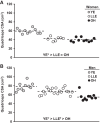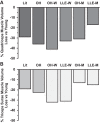Skeletal muscle size, function, and adiposity with lifelong aerobic exercise
- PMID: 31829806
- PMCID: PMC7052586
- DOI: 10.1152/japplphysiol.00426.2019
Skeletal muscle size, function, and adiposity with lifelong aerobic exercise
Abstract
We examined the influence of lifelong aerobic exercise on skeletal muscle size, function, and adiposity. Young exercisers [YE; n = 20, 10 women (W), 25 ± 1 yr], lifelong exercisers (LLE; n = 28, 7 W, 74 ± 2 yr), and old healthy nonexercisers (OH; n = 20, 10 W, 75 ± 1 yr) were studied. On average, LLE exercised 5 days/wk for 7 h/wk over the past 52 ± 1 yr. The LLE men were subdivided by exercise intensity [Performance (LLE-P), n = 14; Fitness (LLE-F), n = 7]. Upper and lower leg muscle size and adiposity [intermuscular adipose tissue (IMAT)] were determined via MRI, and quadriceps isotonic and isometric function was assessed. For the quadriceps, aging decreased muscle size, isotonic and isometric strength, contraction velocity (men only), and power (P < 0.05). In women, LLE did not influence muscle size or function. In men, LLE attenuated the decline in muscle size and isometric strength by ~50% (P < 0.05). LLE did not influence other aspects of muscle function, nor did training intensity influence muscle size or function. For the triceps surae, aging decreased muscle size only in the women, whereas LLE (both sexes) and training intensity (LLE men) did not influence muscle size. In both sexes, aging increased thigh and calf IMAT by ~130% (P < 0.05), whereas LLE attenuated the thigh increase by ~50% (P < 0.05). In the LLE men, higher training intensity decreased thigh and calf IMAT by ~30% (P < 0.05). In summary, aging and lifelong aerobic exercise influenced muscle size, function, and adipose tissue infiltration in a sex- and muscle-specific fashion. Higher training intensity throughout the life span provided greater protection against adipose tissue infiltration into muscle.NEW & NOTEWORTHY This is the first study to examine skeletal muscle size, function, and adiposity in women and men in their eighth decade of life that have engaged in lifelong aerobic exercise. The findings reveal sex and upper and lower leg muscle group-specific benefits related to skeletal muscle size, function, and adiposity and that exercise intensity influences intermuscular adiposity. This emerging cohort will further our understanding of the health implications of maintaining exercise throughout the life span.
Keywords: aging; intermuscular adipose tissue; lifelong exercise; muscle function; muscle mass.
Conflict of interest statement
No conflicts of interest, financial or otherwise, are declared by the authors.
Figures








References
-
- Bang E, Tanabe K, Yokoyama N, Chijiki S, Tsuruzono T, Kuno S. Effects of daily walking on intermuscular adipose tissue accumulation with age: a 5-year follow-up of participants in a lifestyle-based daily walking program. Eur J Appl Physiol 118: 785–793, 2018. doi:10.1007/s00421-018-3812-4. - DOI - PubMed
Publication types
MeSH terms
LinkOut - more resources
Full Text Sources
Medical
Miscellaneous

